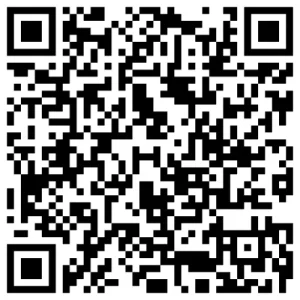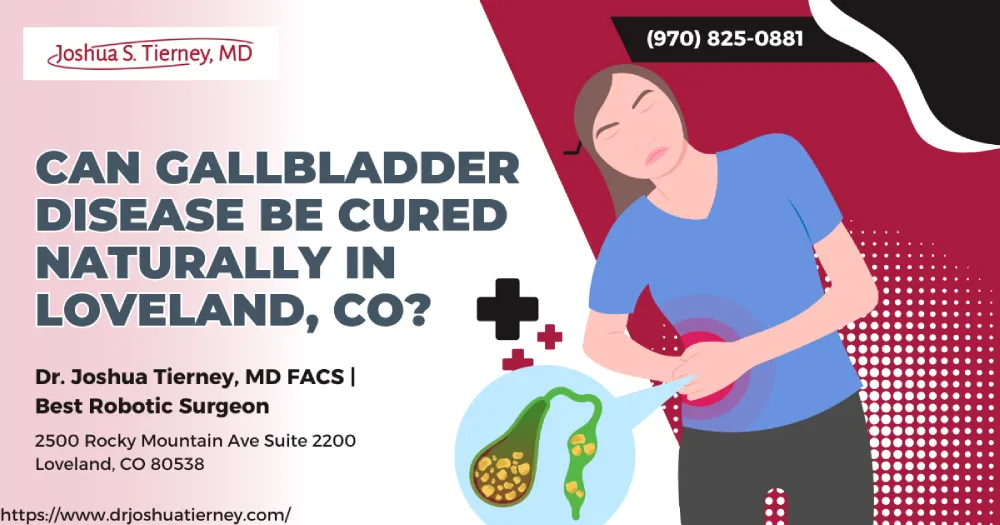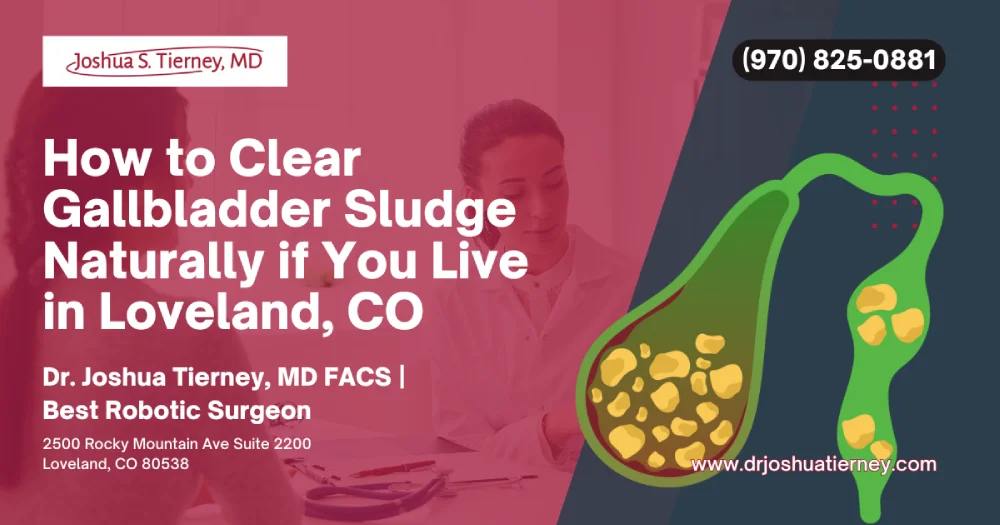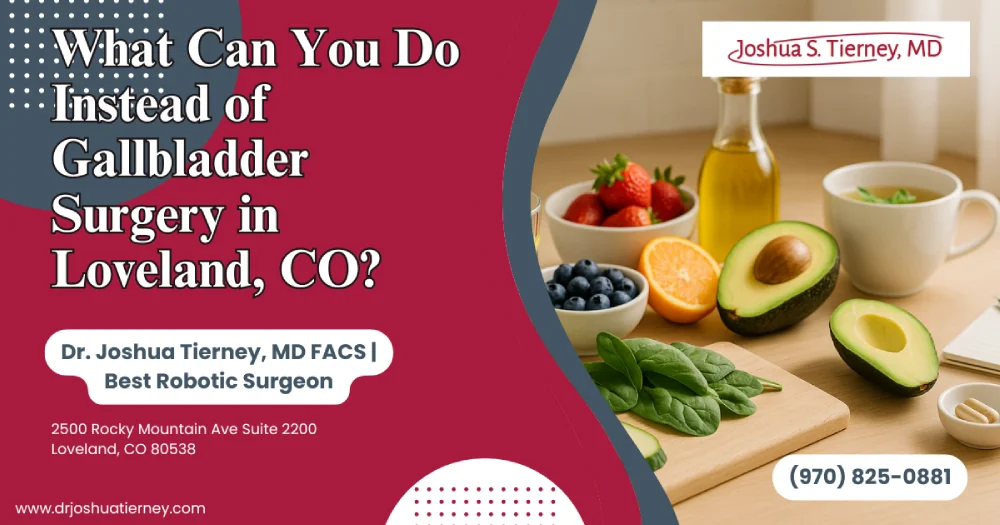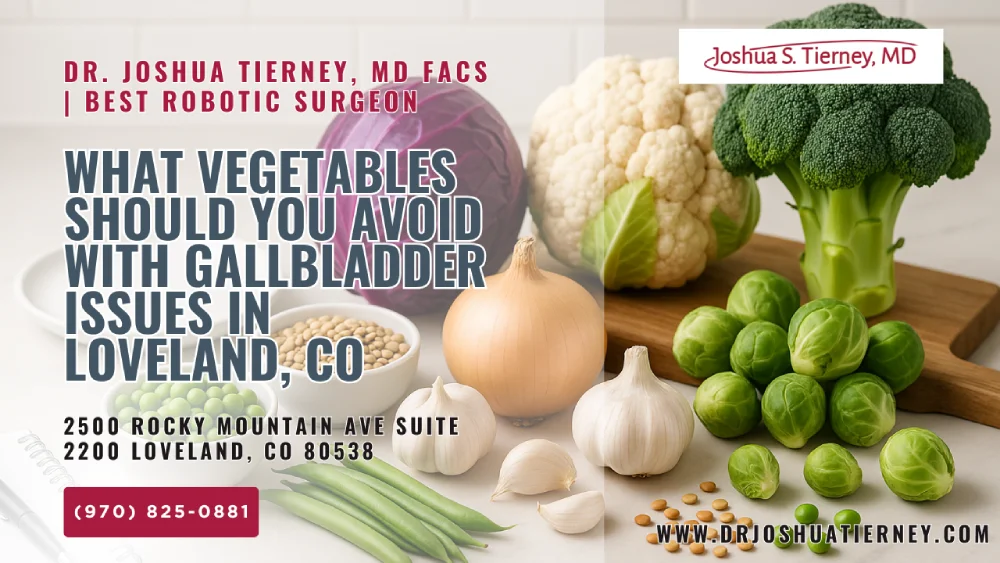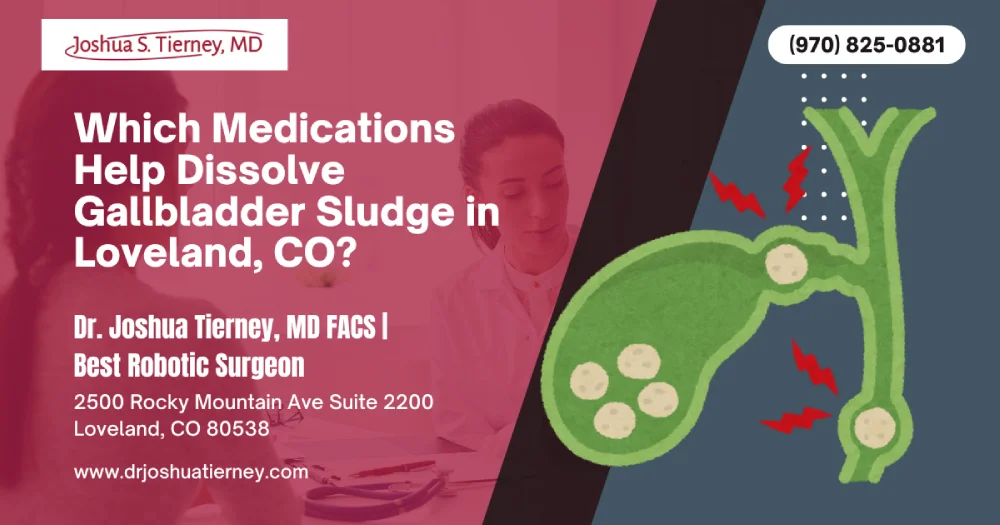There is no reliable scientific evidence that gallbladder disease—especially gallstones—can be cured naturally. While certain lifestyle modifications and complementary therapies may ease discomfort or reduce future risk, the only consistently effective, long-term cure for symptomatic gallstones remains medical or surgical treatment. Anyone in Loveland, CO (or anywhere else) who suspects gallbladder problems should consult a qualified healthcare provider such as Dr. Joshua Tierney before trying unverified “natural cures.”
Living with biliary pain or chronic digestive upset can be frustrating, and it’s understandable to seek a quick, holistic fix. Before you embark on juice fasts, herbal cleanses, or social-media detox plans, let’s examine what science actually says, the safest strategies to support gallbladder health, and when to see a Loveland specialist.
Key Takeaways for Loveland Readers
- Scientific studies confirm no proven natural cure for gallstones or acute cholecystitis; laparoscopic gallbladder removal remains the gold-standard remedy when stones cause pain, infection, or pancreatitis risk.
- Smart lifestyle changes—balanced diet, moderate exercise, gradual weight loss—can lower the chance of new stone formation and ease mild biliary discomfort, but they will not reliably dissolve existing stones.
- Popular online remedies such as apple-juice fasts, extreme olive-oil “flushes,” or high-dose herbal detoxes lack peer-reviewed evidence and can worsen symptoms or trigger dangerous duct obstruction.
- Fever, jaundice, persistent vomiting, or sudden shoulder-blade pain are red flags; seek urgent medical help in Loveland, CO because delaying care can lead to gallbladder rupture, sepsis, or pancreatitis.
- Integrative care works best: discuss any supplements, acupuncture sessions, or chiropractic adjustments with your gastroenterologist or surgeon to avoid drug interactions and to coordinate imaging follow-up.
- Northern Colorado residents have ready access to ultrasound, HIDA scans, ERCP, and minimally invasive laparoscopic cholecystectomy at local hospitals—treatments far safer and more effective than unverified online cures.
Understanding Gallbladder Disease: Types, Causes, and Symptoms
Gallbladder disease is not a single condition; it’s an umbrella term describing several disorders that interfere with bile storage and release. Understanding the distinctions helps clarify why some problems demand surgery while others respond to lifestyle tweaks.
Types of Gallbladder Disease
- Gallstones (Cholelithiasis): Hardened cholesterol or pigment stones that may stay silent for years or spark sudden pain if they block a duct.
- Biliary Colic: Intermittent cramping pain when a stone temporarily plugs but then releases from the cystic duct.
- Acute Cholecystitis: Inflammation and infection of the gallbladder wall—often an emergency requiring antibiotics or surgery.
- Choledocholithiasis: Stones lodged in the common bile duct, elevating pancreatitis risk.
- Gallbladder Dyskinesia: Motility disorder wherein the organ fails to empty effectively, diagnosed by low ejection fraction on a HIDA scan.
Common Causes in Northern Colorado
- Diets high in fried foods, processed fats, or simple carbs
- Rapid weight loss from crash diets or bariatric procedures
- Pregnancy-related hormonal shifts
- Family history—Native American and Hispanic populations have higher prevalence
- Chronic conditions such as diabetes, obesity, metabolic syndrome, or liver disease
Recognizing Symptoms
Typical red-flag symptoms include right-upper-quadrant abdominal pain after meals, nausea, bloating, referred back or shoulder pain, unexplained gas, fever, or jaundice. Any combination of severe pain, vomiting, or yellow skin/eyes warrants immediate professional evaluation.
Why “Natural Cures” Remain Unproven
Intuitively, using herbs or juice cleanses to “melt” stones feels gentler than surgery. Unfortunately, controlled trials demonstrate that these approaches do not reliably work and sometimes cause harm.
Limited Scientific Evidence
High-quality randomized controlled trials on natural gallstone dissolution are scarce. Observational reports occasionally show spontaneous stone passage, but that’s inconsistent and cannot be reproduced at will.
Risks of Delaying Medical Care
Postponing evaluation in favor of untested remedies can lead to:
- Worsening inflammation, risking perforation or abscess formation
- Stone migration into the common bile duct, blocking pancreatic enzymes and triggering pancreatitis
- Escalation from a manageable problem to a life-threatening emergency
“Natural” Does Not Always Mean “Safe”
Concentrated herbal extracts or mega-dose vitamins can:
- Elevate bleeding risk during future surgery
- Interact with blood-pressure, diabetes, or cholesterol medications
- Trigger allergic reactions or liver toxicity, compounding gallbladder distress
Quick Comparison
| Goal | Natural Approaches (Unproven) | Evidence-Based Medical Care |
| Dissolve existing stones | Apple cider vinegar shots, lemon-juice fasts, olive-oil flushes, herbal cleanses | Oral ursodeoxycholic acid (niche use), laparoscopic cholecystectomy (≈95 % long-term success) |
| Prevent new stones | High-fiber diet, regular exercise, gradual weight loss | Same lifestyle steps + periodic ultrasound monitoring |
| Treat acute infection | Garlic, turmeric, heat pack | IV antibiotics, hydration, emergency surgery if indicated |
| Relieve biliary colic | Peppermint tea, yoga, acupuncture | NSAIDs, antispasmodics, surgical removal of gallbladder |
Evidence-Based Ways to Support Gallbladder Health at Home
You cannot magic away stones with a smoothie, but you can help prevent future stones and ease mild symptoms through sustainable habits that bolster overall digestive well-being.
Nutrition & Diet Tweaks
- Increase soluble fiber: Oats, lentils, apples, and chia seeds bind bile acids and improve cholesterol ratios.
- Swap saturated fats (butter, fatty red meat) for monounsaturated fats like olive oil or avocado—but keep intake moderate to avoid bile overproduction.
- Eat smaller, more frequent meals; mega-portions overwhelm the biliary system.
- Stay hydrated: aim for eight 8-ounce glasses of water daily—adequate hydration thins bile and reduces cholesterol crystallization.
- Emphasize leafy greens, berries, and colorful vegetables rich in antioxidants to combat inflammation.
Physical Activity & Weight Management
- Target at least 150 minutes of moderate exercise each week—brisk walks, cycling, swimming, or light jogging help regulate cholesterol.
- Skip crash diets; losing >3 pounds weekly increases gallstone formation.
- Incorporate core-strengthening workouts (planks, Pilates) to improve abdominal circulation and digestion.
Stress Reduction & Restorative Sleep
Chronic stress alters hormone levels and bile composition.
- Practice mindfulness meditation, guided breathing, or gentle yoga for 10-15 minutes daily.
- Strive for 7–9 hours of quality sleep; irregular sleep disrupts gallbladder motility and overall GI function.
Popular Natural Remedies Examined
Blog articles and social-media reels often promote “flushes” and “detoxes.” Here’s the science behind the hype so you can steer clear of risky strategies.
Apple Cider Vinegar & Olive-Oil Cleanses
Proponents claim large volumes of olive oil followed by lemon juice force stones out. In reality, the greenish clumps visible in stool are saponified fat, not true gallstones. Rapid fat ingestion may trigger severe biliary colic or pancreatitis.
Herbal Supplements (Milk Thistle, Artichoke, Dandelion)
Herbs contain antioxidants thought to improve liver function and bile flow. Although milk thistle supports liver enzyme balance, and artichoke extract may enhance bile secretion, no controlled human trials prove they dissolve stones. Always inform your physician before adding botanicals—some interact with anticoagulants or antidiabetic drugs.
Acupuncture & Chiropractic Care
Small pilot studies suggest acupuncture points such as GB-34 and LV-3 may reduce biliary spasm pain. Chiropractic adjustments improve thoracic spine mobility, potentially easing referred shoulder pain. While these therapies can complement medical care, they cannot remove stones.
When to Seek Professional Help in Loveland, CO
Waiting for a cleanse to work can be dangerous. Know when to call a professional rather than sip another detox tea.
Red-Flag Symptoms You Shouldn’t Ignore
- Fever above 101 °F paired with right-upper-quadrant pain
- Persistent vomiting or inability to keep liquids down
- Yellowing of skin or eyes (jaundice), tea-colored urine, or pale stools
- Sharp abdominal pain radiating to back or shoulder lasting >5 hours
Diagnostic Services Available Locally
Loveland patients can readily access:
- Abdominal ultrasound—first-line imaging for gallstones and cholecystitis
- HIDA scan—functional test to measure gallbladder ejection fraction
- MRCP or endoscopic ultrasound—noninvasive visualization of common bile duct stones
Treatment Options: From Medication to Minimally Invasive Surgery
- Ursodiol (ursodeoxycholic acid) can dissolve small, non-calcified cholesterol stones over months, but response rates vary.
- Laparoscopic cholecystectomy—performed through four tiny incisions—allows most patients to go home the same day with minimal downtime and >95 % symptom relief.
- ERCP with sphincterotomy removes duct stones and prevents pancreatitis if stones migrate downstream.
Partnering With Your Healthcare Team for a Personalized Plan
You do not have to choose between “all natural” and “all medical.” A collaborative, integrative approach blends the best of both worlds, honoring natural interests while safeguarding health.
How to Discuss Natural Interests With Providers
Bring a complete list of supplements, teas, or cleanses you’re considering. Ask:
- Could this interact with my medications or anesthesia?
- Might it mask worsening symptoms?
- Are there safer, evidence-supported alternatives?
Creating a Safe Integrative Strategy
- Embrace a Mediterranean-style diet rich in plants, lean protein, and healthy fats.
- Use validated botanicals such as turmeric for inflammation at physician-approved doses.
- Schedule imaging studies as recommended to monitor stone size and gallbladder function.
- Combine gentle yoga or Tai Chi with aerobic exercise for comprehensive metabolic benefits.
Ongoing Monitoring
Even silent stones can suddenly migrate. Arrange:
- Annual ultrasounds if stones are asymptomatic and small.
- Immediate evaluation for any new or worsening pain, fever, or jaundice.
- Regular liver enzyme panels if you’re taking long-term herbs, statins, or estrogen therapy.
Conclusion
Gallbladder disease seldom resolves with natural remedies alone. Surgery remains the only reliable cure for symptomatic stones, while diet, weight control, and stress management help prevent future problems. Question quick-fix cleanses, track symptoms diligently, and collaborate with a Loveland healthcare professional like Dr. Joshua Tierney, who respects holistic wellness. By blending smart lifestyle choices with evidence-based medicine, you safeguard your biliary system for the long haul. If new pain strikes or old symptoms flare, don’t wait—reach out to your doctor and craft a personalized, safe action plan.
FAQs
What is the biggest risk of postponing gallbladder surgery if I have painful stones?
Delaying recommended surgery can let stones shift into the common bile duct, blocking pancreatic enzymes and triggering acute pancreatitis. This complication is far more dangerous than routine laparoscopic cholecystectomy and may require complex ERCP procedures or even ICU care.
Does drinking coffee help or harm the gallbladder?
Moderate coffee consumption (1-2 cups daily) is linked in some studies to reduced gallstone risk because caffeine stimulates bile flow. However, excessive caffeine or added creamers high in saturated fat can aggravate existing symptoms. Balance and moderation remain key.
Can a plant-based diet eliminate existing gallstones?
A well-planned vegetarian or vegan diet lowers cholesterol saturation in bile, reducing new stone formation. Unfortunately, it will not reliably dissolve stones already present. People with symptomatic stones usually still need medical or surgical intervention despite plant-forward eating.
Is pain under my right shoulder blade always gallbladder-related?
Referred shoulder pain is classic for gallbladder irritation, but other conditions—muscle strain, cervical spine issues, or even lung problems—can mimic it. Only a physical exam and imaging can confirm gallbladder involvement, so schedule an evaluation rather than self-diagnosing.
Are gallstones more common during pregnancy?
Yes. Elevated estrogen and progesterone slow gallbladder emptying and increase cholesterol saturation in bile, making stones more likely. Pregnant patients with symptomatic stones should see an obstetric-experienced surgeon; most can safely undergo laparoscopic cholecystectomy during the second trimester if needed.
Does apple cider vinegar shrink gallstones over time?
Despite online claims, no peer-reviewed study shows apple cider vinegar shrinking or dissolving gallstones. Large acidic doses can erode tooth enamel and irritate the esophagus without offering proven gallbladder benefits. Focus on balanced nutrition and professional advice instead.
Can I exercise soon after laparoscopic gallbladder surgery?
Most patients begin gentle walking the same day and resume light activity within a week. Heavy lifting or vigorous workouts should wait 2–4 weeks based on surgeon guidance. Early movement boosts circulation, reduces blood-clot risk, and speeds overall recovery.
How long does ursodiol take to work, and who is eligible?
Ursodiol may dissolve small, cholesterol-based stones over 6–12 months. It is prescribed for patients who are poor surgical candidates or who refuse surgery, provided stones are non-calcified and the gallbladder is still functioning. Periodic ultrasounds track progress.
Are essential oils safe for gallbladder pain?
Some people use peppermint or chamomile essential oils topically for mild relaxation of smooth muscle. There is no solid evidence they treat gallstones, and ingesting oils can be toxic. Always dilute properly and consult a healthcare professional before any essential-oil regimen.
What lifestyle changes are most protective after gallbladder removal?
Post-surgery, focus on moderate healthy fats, ample fiber, regular exercise, and staying hydrated. These habits stabilize bile flow within the intestines, prevent post-cholecystectomy diarrhea, and reduce the chance of bile duct stones. Gradually reintroduce foods and monitor tolerance, adjusting with your dietitian’s help.
